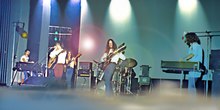|
Neuschwanstein (band)
Neuschwanstein is a progressive rock band which, although never signed to a major record label, were nevertheless able to release an album that was highly regarded in the prog rock scene in the 1970s. Band historyThomas Neuroth and Kaus Mayer met during their school years in Völklingen in 1971[1] and quickly realised that they had common musical interests. They both had a solid background in music and appreciated the structures and lyricism of classical music combined with rock elements. Inspired by Rick Wakeman and King Crimson, the two decided, together with some other school friends, to form a band, which they named Neuschwanstein.[2]
— Thomas Neuroth, Saarbrücker Zeitung, 2018[3]
This band name was no coincidence, as this castle, built by King Ludwig II of Bavaria, represents the romantic era in its most impressive form. At first, they made do with cover versions from the standard Anglo-Saxon rock genre, especially Rick Wakeman songs. Very impressed by his Journey to the Centre of the Earth, Neuschwanstein decided to compose a long piece of instrumental music as well and worked on the musical adaptation of the famous Lewis Carroll novel Alice in Wonderland.[1]  The premiere of this 40-minute piece of music took place in 1974 at a local secondary school. In 1975, Neuschwanstein used it to win a band competition at the Saarland State Theatre in Saarbrücken.[2][1]
— Thomas Neuroth, Saarland music magazine GUCKLOCH, 12/76
The new guitarist Roger Weiler, who had joined the band earlier, significantly shaped Neuschwanstein's sound with his playing. In April 1976, Neuschwanstein booked a small recording studio in Saarbrücken-Güdingen to record Alice in Wonderland on tape. The original master tapes are lost, but a cassette copy existed, which 32 years later, in 2008, was released on CD for the first time in restored form by the French record company Musea.[4] In 2022, Cherry Red Records released a reissue of the album. The recordings have been extensively restored and the original German lyrics have been replaced by English ones. The new lyrics are spoken by Sonja Kristina, lead singer of Curved Air.[5] The label itself describes the album as "The only album in the 'Narrated Rock' genre to be unavailable in English until now." In 1976, there was another new addition, in the form of French singer Frédéric Joos,[6] whose vocals were strongly reminiscent of Peter Gabriel,[2] but also had similarities with The Strawbs' singer Dave Cousins.  Between 1974 and 1978, Neuschwanstein was still only a locally known group, occasionally hired as an opening act for bands like Novalis and Lucifer's Friend.[2][7] This was to change abruptly in 1978. Due to a friendship of their manager and Herman Rarebell, the drummer of the Scorpions, the band was able to book a studio in Cologne to record an album under the direction of Dieter Dierks, producer of the Scorpions.[8] This album, Battlement, was first released by a small local label called Racket Records. In 1992 Musea re-released the album in a new mix by guitarist Roger Weiler, including a bonus track which was not available before. For Musea it became one of the most successful productions of this French label and sold worldwide.[9] Battlement, however, was to remain Neuschwanstein's only production with this line-up. Due to professional changes and other interests, as well as general feelings of discouragement, the group disbanded just one year later, in 1980.[2]
In 2016, after a break of 37 years, a new album by Neuschwanstein, Fine Art,[11] was released. Basically, Fine Art is a "one-man project" by the only original member of Neuschwanstein, Thomas Neuroth.[3] With the help of numerous musician friends, Neuroth created a remarkable album that hardly sounds like Neuschwanstein's original music - despite intensive use of flute - nor like their earlier role models such as Genesis, but much more like the combination of Emerson, Lake and Palmer, classical, romantic and progressive hard-rocking complexity that occurs in the form of a suite.[12] Members of Neuschwanstein photographed during the early "Alice in Wonderland" era Discography
SourcesHelm, Roland; Küntzer, Norbert (2011). Saar Rock History - Volume 1 & 2. Saarbrücken: H. Raueiser GmbH. ISBN 978-3-87661-037-5. References
External links
|
||||||||||||||||||




